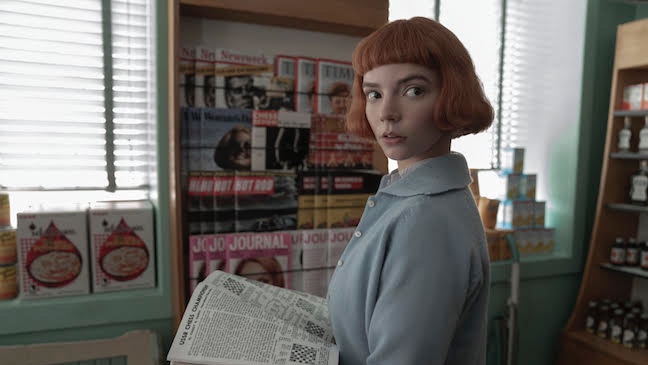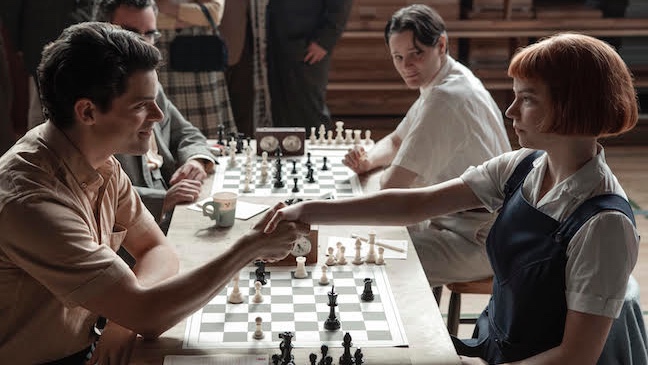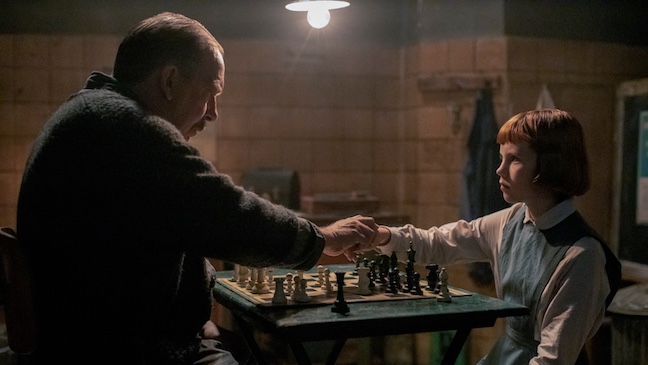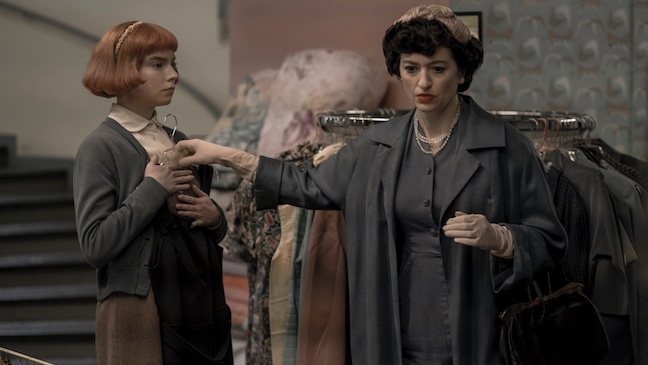
An orphaned chess prodigy struggles with personal issues in The Queen’s Gambit, a seven-episode series currently streaming on Netflix that’s written and directed by Scott Frank (A Walk Among the Tombstones). This is the third time Frank has collaborated with editor Michelle Tesoro, ACE, after the FX pilot, Hoke, and Godless, a 2017 Western that’s also on Netflix.
The Queen’s Gambit was adapted from a novel by Walter Tevis, author of The Hustler and The Man Who Fell to Earth. Like Eddie Felson and Thomas Newton, protagonist Beth Harmon (played as an adult by Anya Taylor-Joy) has extraordinary talents but limited social skills, including crippling insecurities she tries to assuage with tranquilizers and alcohol. While its chess scenes are depicted with unprecedented accuracy, thanks to help from expert Bruce Pandolfini and grandmaster Garry Karsparov, The Queen’s Gambit is really the story of someone taking control of her life.
Before production began, Frank brought Tesoro and cinematographer Steven Meizler to Berlin, where much of the series was shot, for a “chess summit.” It was a chance not just to plan coverage, but to get a feel for the game. As a result, the matches in The Queen’s Gambit — which run an emotional gamut from flirtatious to tense and hostile — feel remarkably authentic.
Tesoro spoke to Below the Line from New Mexico.

Below the Line: In terms of the pandemic, editors are already more or less working remotely.
Michelle Tesoro: For many years now, we’ve never been near production. It’s rare to even be in the same city, but sometimes, I would travel to production when they would shoot key sequences. I did this for the Battle of LaBelle for Godless. Scott and I like to start working on cuts while we are shooting, so we started on Queen’s Gambit with Evercast back in October, 2019, because I wasn’t going to be able to travel there and work with him in person. It’s hard to get Scott to come into the cutting room anyway, since he’s always working on other things, and he likes to write at home. We had offices at Light Iron in Manhattan. With the lockdown, we continued using Evercast and PIX for remote video conferencing. I could connect my Avid and show Scott cuts that way.
BTL: How has your collaboration with Frank evolved?
Tesoro: The team sort of solidified during Godless. Also, I’ve grown as a cutter since 2017, and there were things that I wanted to address, like having the confidence to do what I think the show needed instead of being afraid of what Scott might think. But he’s so open, it’s sort of ridiculous now that I think about it.
BTL: What was his approach to The Queen’s Gambit?
Tesoro: The first thing he told me, and what he reminds everybody, is that this is a book about the cost of genius. Whatever the underlying feeling of a scene, it always has to be ultimately about that.
BTL: What’s interesting in a series about chess is that no one game is shown from start to finish.
Tesoro: That was Scott’s decision ultimately. There were some that did play all the way through, but we ended up cutting them short. When little Beth is learning with Mr. Shaibel [played by Bill Camp], the one where she first beats him was played in its entirety. We eventually decided to fold it into the montage of her learning about chess.
Scott chose what parts of the other games we needed to see. About halfway through the shoot, he said he was convinced the more we stayed on emotions, on people’s faces, the drama of the scenes, the better it would be. Bruce and the other consultants came up with the games, so it just was a question of shooting them correctly.

BTL: How did you approach assembling the games
Tesoro: I think it was about the pacing, and about knowing what mood to highlight. Holding back on when to use close-ups.
For example, the sequence when Beth plays Townes [Jacob Fortune-Lloyd]. The first game is their growing flirtation, the second she’s beating him, he’s realizing he’s in trouble, and in the third she’s humiliating his rook.
At first, we tried to stay on their faces and flirty looks, the wide two-shot of them playing so you get where they are in the game. It wasn’t necessary to see what they were doing on the board until the third game, that’s when you really want to highlight those pieces. Her moving toward the rook, pushing a bit, grudgingly, “Sorry, I don’t mean to embarrass you.”
BTL: How much coverage are you working from?
Tesoro: In that case, they did the whole thing, and it was quite long in the beginning, because I played it longer. For coverage, there was their two-shot, the fifty/fifty where they’re facing each other and you can see the board. There were medium close-ups and extreme close-ups. They didn’t shoot the rook until they were filming the end game, when they shot other close-ups of the board.
BTL: So as the production went on, Frank became more precise about the coverage. Could you suggest coverage?
Tesoro: When I went to the chess summit in Berlin, I sat in with Scott and Meizler as they prepared shot lists for some of the games as well as the other locations. They shot the Mexico City hotel there and Methuen, the orphanage. I think Russia, too.
It was great to talk about coverage, especially transitions. I would say, “Well, you could transition here, but also cover it a different way in case you need to get out sooner.”
He also was seeing what worked as they shot. He knew what he needed. And sometimes he would call from Berlin to ask if I needed any pickups. Like when Beth is looking at the ceiling, I told him he needed a point-of-view shot of her looking up. Since they were shooting 8K, I told them to remember the lighting, because if they ran out of time and couldn’t get all the pickups, I could punch in on the frame and pull new shots from it.
As we went along, we talked about what we needed. We make a list and before they wrap, a second unit shoots from that and the script supervisor’s list.

BTL: Having read the novel and knowing what will happen, I was still unsettled by the story. Watching the film it seems as if Beth is on the verge of disaster at any moment. That’s partly due to performances and cinematography, but how does editing contribute to that sense of unease?
Tesoro: The key is what you don’t show, and how long you’re in a place before your audience understands where they are. It’s why pacing is important. Not staying in the scene too long, staying with the character long enough that you get the idea, and then jolting ahead. Always being with the characters, yet ahead of them.
It’s about not revealing everything. Like not having too much tail at the end of scenes, not having “looks” at the very end, so you feel that you’ve been jolted out of a scene. You’re never really settled until we want you to be settled.
BTL: Is that in your original approach, or something you modify as you see how scenes play?
Tesoro: It depends on the scene, but you have to know where you want to land, like when Beth goes to the sorority party. The scene isn’t her talking with the girls, the scene is her having these expectations and then rushing back home. She realizes she doesn’t fit, she’s out of place, “How do I get out of here?” There are points you want to run to and then stop. The first place to land is when she spots the liquor, then she rushes back home and you’ve got to get her back to her bed.
I see it as more an entire sequence instead of the scene in the living room and then the scene in the bedroom. You have to see the whole show that way. That’s why it’s hard when you’re cutting dailies, you’re cutting scenes and kind of flying blind. You have to see it as a whole arc.
Scott wrote it that way, as little scenes that make up one big sequence. It’s how I think about it when I’m on a micro-level, working on a scene, finding the important parts, where to land, where I need to get people to, where we can kind of scurry through a little bit. It’s the same when I am looking at big sequences, and then across episodes as well. Nowadays everybody just binges through series, and you have to be mindful of that.

BTL: Can you think of an example of trying to stay ahead of the audience?
Tesoro: There’s a point in Episode 4 when Alma [played by Marielle Heller] is trying to convince Beth to take a break and relax. There used to be a lot more to the scene: the drinks arrive, Alma says she hasn’t been feeling well, Beth says she is going to take a walk, and then we cut to the zoo.
All of that took the momentum out of the scene, and it revealed too much about Alma. We ended up cutting from Alma saying, “I’m convinced relaxation can only improve them,” to Beth thinking it over, and then to what Beth decides to do.
You keep ahead of the audience by showing instead of telling, not letting the air out of a scene. There were a few other moments like that. During perhaps our third producer’s cut, Scott and I went through the whole show together looking for lifts like these, looking for ways to not lose momentum, to keep the tension going.
BTL: How much material were you working with?
Tesoro: Scott didn’t really shoot a whole lot. We were blessed by the fact that our average daily count was about an hour, maybe three hours of footage at the most. They started shooting last August through December, 81 or 82 days. We took a couple of weeks off, and then we were formally in post-production editorial from January to the beginning of August. We stayed on schedule despite the pandemic.
I worked with two assistants. We would look at the footage, I’d tell them how I would cut it, and give them a crack at it. We had four others in the post-production staff. Because Scott likes to hear sound and music right away, we had a music editor and an on-call sound editor. It was a huge lift off my department’s shoulders. We could focus on the picture instead of spending half the day cutting sound.
It felt like one big movie, very similar to how we approached Godless.
BTL: Godless must have had a lot more material.
Tesoro: That was actually 120 days of shooting, plus splinter units that were shooting at the same time. It depressed me to think about the number of hours I would get each day. That was the first question I would ask my assistant, “How long do I have to be underwater today?”
It was a lot of footage, but a lot of fun. I really loved that show, and I got a husband out of it. He was the special effects foreman on the show. Scott brought me out to Santa Fe and introduced us, and then Scott officiated at our wedding in Telluride in October. He wrote an awesome ceremony for us, and that’s when I realized he had intended for us to meet all along.
The first season of The Queen’s Gambit is now streaming on Netflix.





